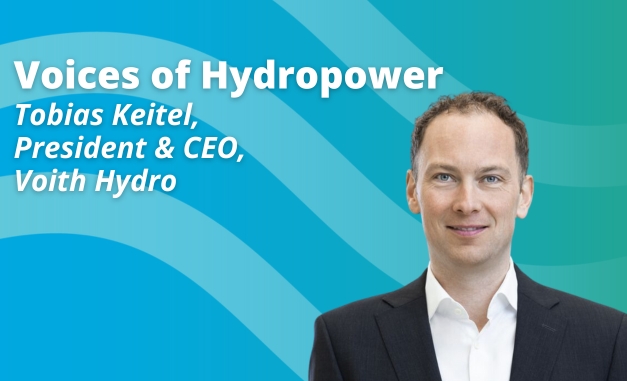Electricity storage: a changing landscape
This article is written in collaboration with the International Renewable Energy Agency (IRENA), and is featured in the 2017 Hydropower Status Report. You can download the report in full here for analysis of other key topics for the hydropower sector and insights into regional trends.

The rapid growth of variable renewable energies (VRE) such as wind power and solar PV in recent years is increasing the need for rapid-response energy storage technologies. The landscape for grid-scale energy storage is evolving from being almost exclusively supplied by pumped-hydropower storage to include a number of new technologies. Of these, battery storage is evolving and growing at a rapid pace, even as pumped hydropower storage continues to supply over 95 per cent of energy storage requirements worldwide.
It is widely recognised that the transition towards cleaner and more sustainable energy systems will require a significant increase in power system flexibility. Flexibility in this context refers to the ability of a power system to maintain a reliable and continuous service when faced with potentially rapid changes in supply or demand.
Augmenting power system flexibility can be achieved by a variety of options, including: supply-side improvements, demand-side management, increased transmission networks, increasing system efficiencies and the provision of added energy storage.
This article focuses on energy storage and explores the different but potentially complementary roles of emerging utility-scale battery storage systems (BSS) and more established pumped hydropower storage systems (PHS).
In the traditionally fossil-fuel dominated power systems, flexibility has been almost solely controlled by the supply side. The existing fleet of power stations is operated to react to variations in demand. Baseload power is typically supplied by run-of-river hydro, coal and nuclear, which are encouraged by virtue of their technical and economic nature to have continuous operation.
Rapidly-responding generation such as hydropower with storage capacity and gas- or oil-fired power plants are capable of meeting load variations at sub-hourly, hourly, daily and seasonal scales. Some capacity is kept in reserve in case a power station or transmission line unexpectedly goes offline. Thus, non-baseload stations require quick responses, which is often provided by plants that are online but working below their full potential.
This allows for a quick response, but decreases the efficiency of the entire system, which inevitably increases the overall system cost of operation.
Increasing the proportion of VREs inherently reduces the flexibility of a power system. High penetration of VREs into an existing energy system will in effect will introduce more variability on the supply side, while also displacing existing flexible technologies. Electricity storage technologies act as both supply and demand in the system, adding flexibility, and so have the potential to increase the system’s overall efficiency and reduce overall costs.
Currently, PHS remains the primary technology used to provide energy storage services on the grid scale. PHS first saw commercial use in the early 20th century and experienced a surge in new capacity beginning in the 1970s and 1980s as a reaction to energy security concerns, and to balance baseload power produced from nuclear and coal-fired power plants. At that time, PHS allowed for the constant and efficient baseload generation, typically absorbing excess power at night and feeding it back to the grid during peak daytime hours.
There is little doubt that both pumped hydropower storage and battery storage will play a fundamental role in future energy systems."
However, as growth in nuclear has stagnated, and more and more variable renewables are connected to power grids, the shifts in supply and demand are becoming more dynamic in magnitude and time. Solar power available during daytime can vary subject to cloud cover and rainfall, while fluctuations in wind speeds throughout the day can create more supply-side fluctuations.
While traditional pumped storage systems were used to ‘time-shift’ electricity production to optimise power production, i.e. charging (pumping) at night when excess low-cost electricity was available and generating during the peak hours, storage systems may now be required to cycle multiple times in a day, or remain offline for long periods, depending on weather conditions.
Thus, the landscape for energy storage is changing with each added megawatt of solar and wind, allowing alternatives to pumped storage to enter the market. According to the Global Energy Storage Database, traditional PHS-dominated storage systems have mainly been used for time-shifting (arbitrage) of electric energy (85.2 per cent), to take advantage of pricing differentials between on-peak and off-peak periods. As variable renewables reduce opportunities for arbitrage, new technologies are fast emerging, offering an increased range of flexibility applications aimed at integrating variable renewables into the system.
PHS systems are evolving to provide additional operating flexibility to balance fluctuations in the system. In traditional PHS, power regulation is only available when generating, however, variable-speed PHS systems are being implemented to increase plant efficiency and flexibility by allowing for power regulation in both pumping and turbine mode. Ternary systems, consisting of a motor-generator and separate pump and turbine set, can allow for simultaneous pumping and generating, which allows for even finer frequency control.
Battery storage systems (BSS) are currently one of the fastest-growing electricity storage technologies, and are now capable of providing both off-grid and grid-scale storage. The proportion of total installed battery capacity at nearly 2 GW at the end of 2016 is still far less than the total pumped storage capacity, currently at around 150 GW.
From a technological perspective, batteries are a mature technology; however, significant cost barriers continue to impede the full integration of BSS into the power sector. BSS and PHS systems essentially operate in the same manner. BSS, however, have faster response times, but typically cannot sustain that power output for extended periods of time.
This means that BSS are well suited to managing power quality. In addition, BSS do not have the same site-specific requirements as PHS, allowing them, for example, to couple with variable renewable technologies at source and mitigate fluctuations before power is sent to the grid.
Hybrid systems have been developed in many locations where PHS facilities are operated jointly with VRE systems to balance the intermittency of the variable generation source directly though the operation of the PHS plant. For grids with very weak interconnections, or isolated grids, such as island systems, such fluctuations could be much more damaging. This service is particularly suited to batteries given the need for rapid, quick charging and discharging.
The changing characteristics of power systems, brought about by growing VREs, provides new opportunities for electricity storage technologies."
BSS are emerging as an increasingly important large-scale storage option and have grown exponentially over the past ten years. One of the key drivers of this growth has been its rapidly decreasing costs and favourable policy settings, potentially mimicking the rapid growth seen in the solar PV industry. According to the International Renewable Energy Agency (IRENA), it is estimated that prices will continue to fall rapidly until 2030, with cost declines of 50 per cent or more to be expected for most battery technologies.
Most of the cost reductions are expected to be driven by rapidly growing economies of scale, and innovations that reduce costs and further increase performance. IRENA will release a report examining the market and cost outlook for battery storage technologies to 2030 later in 2017 exploring these issues in detail.
At the same time, the growing use of electric vehicles represents a potential additional source of flexibility with the right market arrangements, as their on-board batteries could be used by the grid. Although not their primary role, the scale of their deployment means they could become an importance source of flexibility. The global electric vehicle fleet reached a total size of 1.2 million vehicles (including both battery electric vehicles and plug-in hybrid vehicles), with an estimated total battery capacity of 20–40 GWh, and a total electricity demand of 2.5 TWh in 2015.
There is little doubt that both pumped hydropower storage and battery storage will play a fundamental role in future energy systems. As more battery technologies are developed and variable-speed PHS technology becomes more advanced and affordable, both forms of energy storage can be utilised optimally to meet the ever-growing need for energy storage.
The changing characteristics of power systems, brought about by growing VREs, provides new opportunities for electricity storage technologies, which by their own part can also play a significant role in restructuring current energy systems. In its Roadmap for a Renewable Energy Future, IRENA estimates that 150 GW of battery storage and 325 GW PHS is required to double the share of renewable power generation by 2030.










